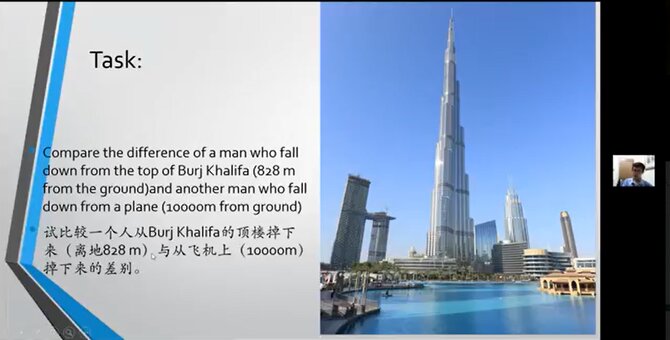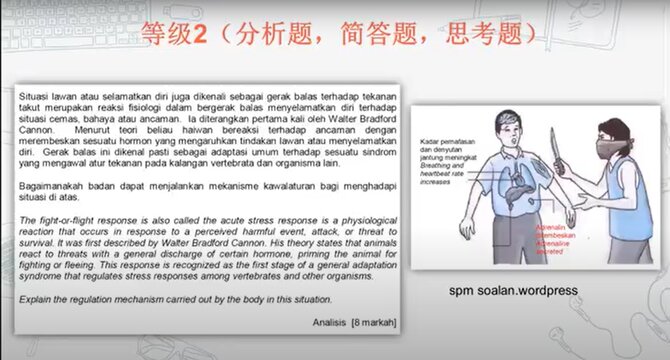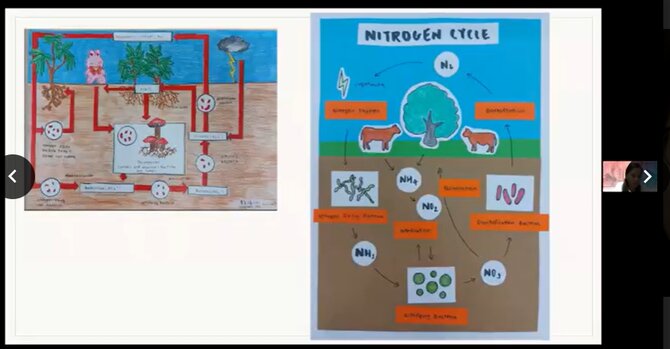Reported by:
Sophia Ng Szu Fei Sr2ScB
Kuen Cheng High School’s new direction in education has shed new light on the mundane traditional exams. Students are not only assessed based on theoretical knowledge, alternatively, they are also tested in multiple ways. For instance, mind maps, home experiments, researches and quizzes. As our Principal stated, “The pandemic is a valuable opportunity for our School to consider a new approach in education. Traditional assessments are not sufficient in preparing students who are soon going into the fast modernizing society, thus students nowadays have to cope with mentally challenging learning styles. Our School is still in the progress of implementing modern-century learning and it can be seen evident from the recent Student’s Performance Record.
A sharing session was held on the 14th of August, aiming to promote diverse assessment methods amidst the pandemic. Two esteemed figures joined the session to give feedback on the school’s teaching method, namely Dr Teoh Hee Chong from the Unified Curriculum Committee, and the Principal of Tzu Chi Senior High School, Madam Lee Lin-Hui. Each Subject Department had to report on their teaching progress (multiple assessments) by a teacher representative. This article focuses on Science subjects, including mathematics, physics, chemistry and biology.
Mathematics Department
The representative teacher, Madam Bur Peck Yeen started the sharing session by explaining how the students were graded. They came up with a rubric of all important aspects such as class assessments, homework, class participation, projects and so on. Each year had a different rubric according to the syllabus. Such an example was given to Junior students. 50% of the marks are from online assessments, 20% for quizzes, 25% for homework and class participation, while the remaining 5% are for projects. The rubric can be seen below.
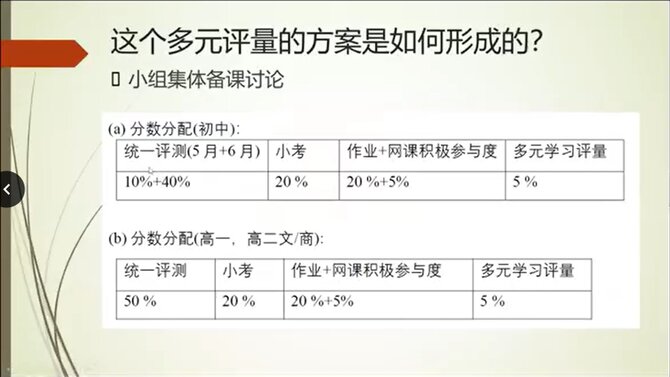 Rubric Rubric |
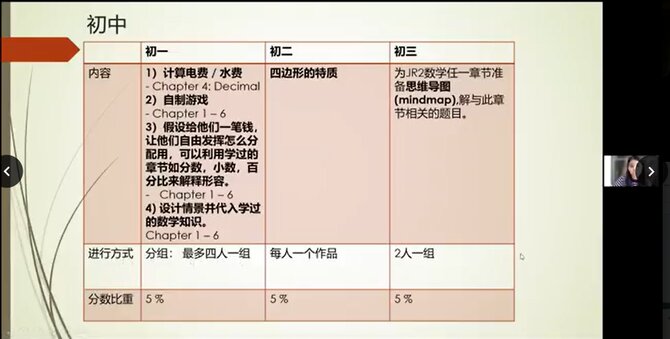 |
Later on, she mentioned that the Mathematics Department had been using several online applications, such as Kahoot and Quizizz, to facilitate their teachings. Although they faced several challenges due to their unfamiliarity with the apps and uncooperative students, they realised that projects are a better way of accessing students. Junior Middle One students could choose their own projects, for example, calculating electricity and water bills, financial management, games and many more. Madam Bur expressed her satisfaction with their project as they incorporated theoretical knowledge into real-life scenarios, which is crucial in modern century learning. Junior Middle Two and three students were also impressive in their projects.
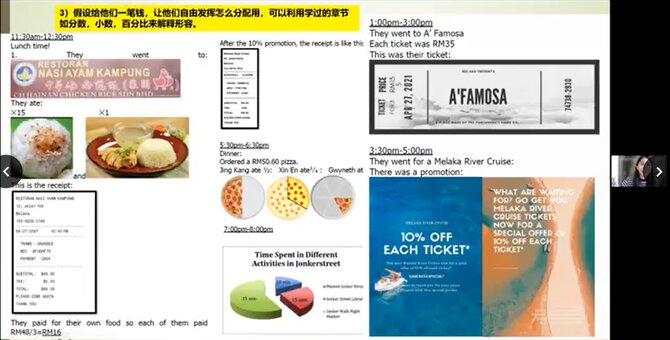 Jr 1 students’ project Jr 1 students’ project |
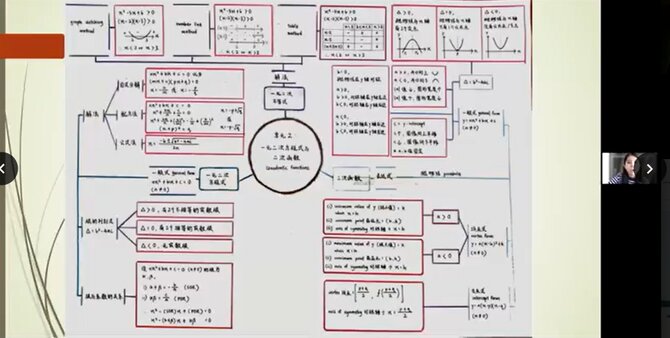 Jr3 students’ project Jr3 students’ project |
Escalating to senior students, Madam Bur focused on Senior Middle Two Arts stream students. They were tasked to apply mathematical concepts such as differentiation in real life. For example, the students were assigned to calculate the maximum volume of an object around their house.
Madam Bur concluded with the hardships faced by both students and teachers. Students were heavily burdened with overloading projects and had no clue about completing the project. Thus, it was the teacher’s position to guide and facilitate them. She felt confident that the changes made today would be beneficial once physical classes resume.
Physics Department
After that, it was the sharing session of the Physics Department, represented by Mr Lee Woon Chew. Contrary to the other presentations, he had a different experience with online learning. According to Mr Lee, “at first, I thought exam-based assessments were sufficient to test students, and I trusted them.” “However, to my despair, most of them cheat during tests by either copying from their peers or the internet,” said Mr Lee disappointingly. We must not take online learning for granted. He then used the finance practice The Great Acceleration from McKinsey & Company as a reference to explain his idea on online learning.
The two teaching principles were sustainability and progression. The Department believed that assessments are essential to enhance understanding of specific topics. They also had some new implementations namely authentic and alternative assessments. Authentic assessments mainly focus on students’ ability to apply certain physics concepts. He showed us a course work on calculating the terminal velocity of a person jumping off the tallest building in the world, Burj Khalifa after he taught them the concepts of determining velocity. The assessment was conducted in groups so that the weaker students could learn from the discussion as well. Alternative assessment refers to class participation which includes either raising their confusion through chat or their microphones.
Before ending his presentation, he reflected on their mistakes throughout the year. Teachers play an important role during the pandemic. They have to dedicate their time to students for revision and enhance their interest in learning. Exam marks distribution must also be put into consideration. He ended by stating that a teacher’s conduct is more important than a student’s behaviour.
Biology Department
The same goes for the Biology Department, they came up with the initial rubric of the mid-term marks distribution through discussion and the following are the marks distribution of the mid-term exam.
i) 10 % – homework
ii) 20 % – class assessments
iii) 10 % – Individual’s class participation (Kahoot, Peardeck, Quizizz)
iv) 60 % – Assessment of Learning Progress
They created various levels for assessing their student’s progress with 20 marks for accomplishing each level. Levels one and two were individual works. The former focused on exam-based questions and the latter were KBAT questions. At the final level, students have to create mind maps, experimental questions, videos and research reports.
They believed that the different levels would enable them to keep track of the students’ progress during the pandemic. They may continue to carry on such projects after evaluating its pros and cons.
Chemistry Department
Next up, Mr. Foo Ming Choong presented his results in the multiple assessments. They were creative in coming up with projects for students. As an example,
1) Create a project on stones via the Canva website for Junior Middle One students;
2) Home Experiments for Junior Middle Two students;
3) Group Discussion for Junior Middle Three students on scenarios given by teachers;
4) Create an ebook on the discovery fathers of the periodic table for Senior Middle One students;
5) DIY experiments on creating plastic from milk based on their understanding of polymers for Senior Middle Two Science stream students.
Sadly, due to the compelling syllabus of Senior Middle Three Chemistry, they were assessed based on tests. They realised that such assessments were very useful as they could evaluate students from multiple ways.
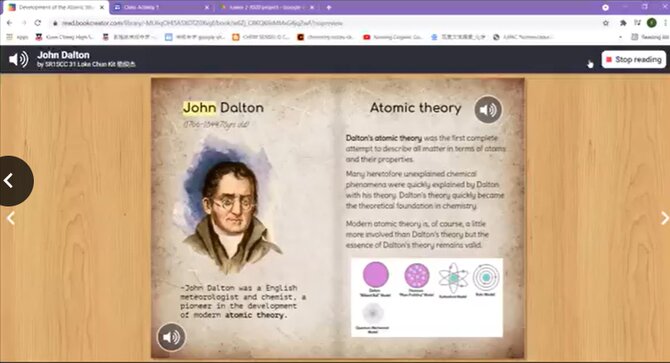 Sr1 students’ online book Sr1 students’ online book |
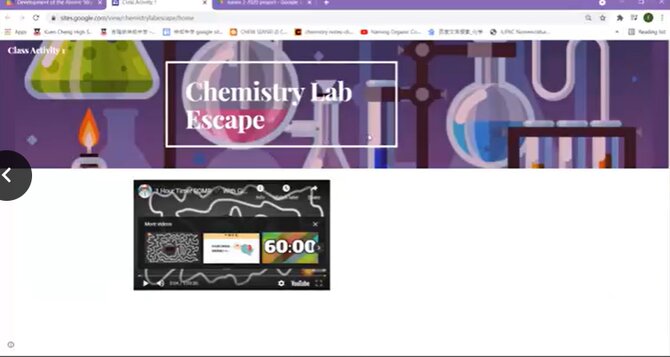 2020 Sr1’s students chemistry escape room 2020 Sr1’s students chemistry escape room |

